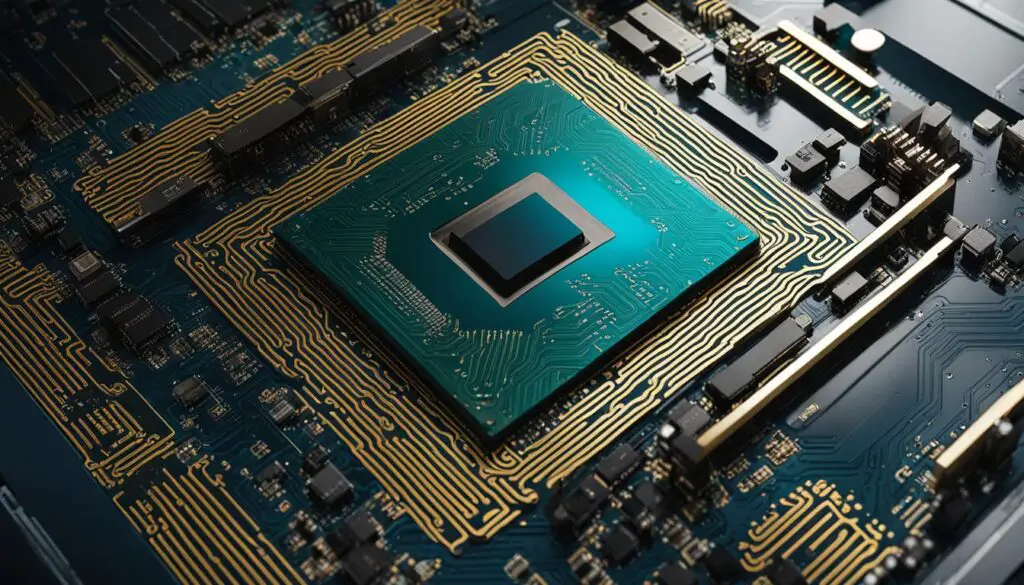The technological landscape is constantly evolving, driven by groundbreaking discoveries and cutting-edge innovations. In this article, I will explore some of the most recent breakthroughs that are reshaping the world of technology. These advancements have the potential to revolutionize industries and pave the way for exciting new possibilities.
One of the major breakthroughs in the semiconductor industry is the introduction of three groundbreaking chips. These chips, namely NVIDIA’s Blackwell GPU, Cerebras wafer-scale engine chip, and EnCharge analog chip, are pushing the boundaries of processing power and efficiency.
NVIDIA’s Blackwell GPU has redefined performance standards in the AI hardware sector. With 208 billion transistors, it offers quadruple the training performance and a staggering 30-fold increase in inference performance compared to previous models. Its dual-die design and advanced packaging technology contribute to its exceptional capabilities.
The Cerebras wafer-scale engine chip, with its 4 trillion transistors, simplifies AI tasks and allows for the handling of massive AI models and datasets. Its monolithic design eliminates complexities and offers unprecedented speed and efficiency, opening up new possibilities in fields such as scientific research, drug discovery, and climate modeling.
The EnCharge analog chip introduces a pioneering approach to computing with its energy efficiency and charge-domain computation. It is at least 20 times more energy-efficient than its analog predecessors, addressing the persistent memory bottleneck and finding utility in edge computing and IoT devices.
These breakthroughs are poised to reshape the technological landscape, enabling advancements in fields like AI, computer vision, and edge computing. The possibilities are vast, and the impact of these innovations is set to be felt across various industries.
Table of Contents
Key Takeaways:
- The semiconductor industry is witnessing breakthrough chips that challenge the limits of Moore’s Law and offer unparalleled performance.
- NVIDIA’s Blackwell GPU sets new performance standards with its quadruple training performance and 30-fold increase in inference performance.
- The Cerebras wafer-scale engine chip simplifies AI tasks and enables the handling of massive AI models and datasets.
- The EnCharge analog chip pioneers energy efficiency and addresses the persistent memory bottleneck in computing tasks.
- These breakthroughs have the potential to reshape industries and accelerate advancements in AI, computer vision, and edge computing.
NVIDIA’s Blackwell GPU: Redefining Performance Standards
NVIDIA’s Blackwell GPU is a groundbreaking chip that is poised to redefine performance standards in the AI hardware sector. With an impressive 208 billion transistors, this GPU stands at the forefront of cutting-edge innovations, offering unparalleled processing power and efficiency.
The Blackwell GPU sets a new benchmark in training performance, delivering a quadruple increase compared to its predecessors. Its remarkable 30-fold increase in inference performance further solidifies its position as a game-changer in the AI hardware industry.
This groundbreaking chip owes its exceptional capabilities to its innovative dual-die design and the utilization of TSMC’s advanced CoWoS-L packaging technology. These advancements enable the Blackwell GPU to handle the most demanding tasks with unprecedented speed and efficiency.
With its exceptional performance in training and inference, the Blackwell GPU is poised to accelerate breakthroughs in diverse fields, including natural language processing, computer vision, and autonomous systems. This GPU opens up new possibilities for AI applications and research, revolutionizing industries that rely on advanced computational power.
“The Blackwell GPU’s unmatched performance is a testament to NVIDIA’s commitment to pushing the boundaries of AI hardware. Its quadruple increase in training performance and 30-fold increase in inference performance provide researchers and developers with the tools they need to tackle complex AI challenges.”
NVIDIA’s investment in higher fabrication costs further underscores the company’s dedication to maintaining its leadership position in the AI hardware sector. This commitment ensures that the Blackwell GPU remains a trailblazer in performance standards, driving advancements in AI technology.
As the AI hardware sector continues to evolve, NVIDIA’s Blackwell GPU stands as a testament to the relentless pursuit of performance and the transformative potential of cutting-edge innovations. By redefining performance standards, this groundbreaking chip is reshaping the future of AI and propelling advancements across industries.
Performance Comparison of NVIDIA’s Blackwell GPU
| Performance Metrics | Blackwell GPU | Previous Generation GPU |
|---|---|---|
| Training Performance | Quadruple increase | N/A |
| Inference Performance | 30-fold increase | N/A |
| Transistor Count | 208 billion | Varies |
Cerebras Wafer-Scale Engine Chip: Handling Massive AI Models
The Cerebras wafer-scale engine chip is a breakthrough in the semiconductor industry chip architecture. With an astounding 4 trillion transistors, this chip defies the limits of Moore’s Law and pushes the boundaries of what is possible in AI hardware. Its monolithic design eliminates the complexities of interconnecting multiple GPUs, streamlining AI tasks and unlocking unprecedented speed and efficiency.
By leveraging the wafer-scale design, the Cerebras chip can handle massive AI models and datasets with ease. This opens up new opportunities for training and deploying large-scale AI systems, revolutionizing fields such as scientific research, drug discovery, and climate modeling. The ability to process vast amounts of data quickly and efficiently is essential in these areas, and the Cerebras chip delivers on these demands.
The impact of the Cerebras wafer-scale engine chip extends beyond the realm of AI. Its exceptional processing power and efficiency have the potential to drive advancements in various industries, enabling faster and more accurate simulations, data analysis, and decision-making processes.
The Cerebras wafer-scale engine chip is a game-changer in the semiconductor industry. Its massive transistor count and simplified architecture pave the way for handling massive AI models with unparalleled speed and efficiency. This breakthrough has the potential to reshape the landscape of AI and usher in transformative advancements in fields that rely on data-intensive computations.
Advantages of the Cerebras Wafer-Scale Engine Chip:
- Monolithic design eliminates complexities and enhances efficiency
- Can handle massive AI models and datasets
- Unprecedented speed and processing power
- Potential to revolutionize scientific research, drug discovery, and climate modeling
- Opens up new opportunities for fast and accurate data analysis
With the Cerebras wafer-scale engine chip, the future of AI and data processing looks more promising than ever before. Its remarkable capabilities are poised to drive innovation and accelerate breakthroughs across various industries, paving the way for a faster, more efficient, and intelligent future.

EnCharge Analog Chip: Pioneering Energy Efficiency
The EnCharge analog chip revolutionizes computing with its groundbreaking approach to energy efficiency and performance. By leveraging near-memory or in-memory computing through its innovative use of metal capacitors, the EnCharge chip offers unparalleled energy savings and computational power.
Compared to its analog predecessors, the EnCharge chip demonstrates at least 20 times greater energy efficiency. This significant leap forward in energy savings is set to address the persistent memory bottleneck that plagues computing tasks, enabling faster and more efficient data processing.
One of the key advantages of the EnCharge chip is its ability to bring computation closer to memory. By minimizing the need for data movement, it reduces energy consumption while improving overall performance. This breakthrough in charge-domain computation has far-reaching implications, particularly in the fields of edge computing, IoT devices, and battery-powered applications where energy efficiency is crucial.
FAQ
What are the groundbreaking chips in the semiconductor industry?
The groundbreaking chips in the semiconductor industry include NVIDIA’s Blackwell GPU, Cerebras wafer-scale engine chip, and EnCharge analog chip.
What are the key features of NVIDIA’s Blackwell GPU?
NVIDIA’s Blackwell GPU offers quadruple the training performance and a staggering 30-fold increase in inference performance compared to its predecessors.
How does the Cerebras wafer-scale engine chip handle massive AI models?
The Cerebras wafer-scale engine chip has 4 trillion transistors and a monolithic design that simplifies AI tasks and allows for the handling of massive AI models and datasets.
How does the EnCharge analog chip achieve energy efficiency?
The EnCharge analog chip leverages charge-domain computation and is at least 20 times more energy-efficient than its analog predecessors, addressing the persistent memory bottleneck in computing tasks.


